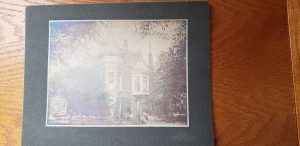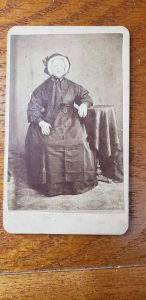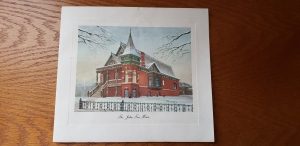Continue with me as our Journey Through the Land of Serendip comes to an end. You may recall from the first two installments, this past summer two separate storylines from this blog collided in a wonderful adventure. We wrap up that adventure with one last stop on our journey through the Land of Serendip in Lake Geneva, Wisconsin.
Our journey began with a visit to Roseland and South Holland on the south side of Chicago. We then spent two days reminiscing and reuniting dad’s ashes with mom’s at Green Lake, Wisconsin. On that Monday, it was time to head home, but not by our familiar route. We had been invited to stop at the home of Duane and June DeYoung. Duane is my 3rd cousin, descended from Jan and Aagje Ton through their daughter, Pieternella, sister of my great grandfather, their son George. You may recall from the first leg of our journey, Duane had reached out to me after reading one of my posts here on Rivers of Thought.
Always game for an adventure, Carmen, Brad, and I decided to take the backroads from Green Lake to Lake Geneva and stay off the interstates. Wisconsin is a beautiful state and we enjoyed the rolling hills, the small towns, and the fields and pastures as we traveled the web of state roads, county roads, and well, even a gravel road or two. Our trip to Lake Geneva was without incident, well…except for that car I didn’t see coming on one of the little country roads, almost pulling out in front of it. No harm, no foul…just an increased heart rate for the three of us!
 Duane had inherited a wonderful collection of photographs and keepsakes from his parents. His collection included many items of Ton family history. His prized possession was a painting he had commissioned based on a photograph of Jan and Aagje’s house in Roseland. Jan and Aagje spent most of their years on a farm on the banks of the Little Calumet River. When Jan retired from farming, he had a home built for their family “closer to town” in 1893. Their home stood at 416 W. 103rd Street until 1960 when it was torn down to make room for a parking lot.
Duane had inherited a wonderful collection of photographs and keepsakes from his parents. His collection included many items of Ton family history. His prized possession was a painting he had commissioned based on a photograph of Jan and Aagje’s house in Roseland. Jan and Aagje spent most of their years on a farm on the banks of the Little Calumet River. When Jan retired from farming, he had a home built for their family “closer to town” in 1893. Their home stood at 416 W. 103rd Street until 1960 when it was torn down to make room for a parking lot.
His collection included photographs of Jan and Aagje, as well as, Lijntje (Steenbergen) Van Der Sijde, Aagje’s mother. There was also a Christmas Card sent by the Pullman Bank & Trust that featured Jan and Aagje’s house. It was this image that Duane used for the painting.
sent by the Pullman Bank & Trust that featured Jan and Aagje’s house. It was this image that Duane used for the painting.
 We spent hours pouring over his collection. Especially the album that contained the history of the Ton Family Reunions. There was a copy of almost every program dating back to the first reunion in 1896, the year Jan died. After his death, his son Cornelius organized a reunion to honor his father. The family (and the reunion) continued to grow. By 1911 the family decided to incorporate and elect officers. In 1945, the 50th-anniversary reunion, the family boasted 1,500 members. Life Magazine sent reporters and photographers and dedicated several pages in the September issue to the reunion. The Reunions would last another 10 years. In 1954, the members voted to make the 1955 reunion their last.
We spent hours pouring over his collection. Especially the album that contained the history of the Ton Family Reunions. There was a copy of almost every program dating back to the first reunion in 1896, the year Jan died. After his death, his son Cornelius organized a reunion to honor his father. The family (and the reunion) continued to grow. By 1911 the family decided to incorporate and elect officers. In 1945, the 50th-anniversary reunion, the family boasted 1,500 members. Life Magazine sent reporters and photographers and dedicated several pages in the September issue to the reunion. The Reunions would last another 10 years. In 1954, the members voted to make the 1955 reunion their last.
The programs included a wealth of information, including, births, deaths, marriages, and military service. There were even lyrics to the Ton Family song printed in most years. The reunions included speeches, games and activities, and a lot of storytelling!
A Journey Through the Land of Serendip has been all about collisions of storylines…the discovery of Jan and Aagje’s service on the underground railroad, colliding with the series of fairy tales I had written surrounding my father’s death, and lastly, the collision with the publication of the second edition of mom’s book. Lastly…or so I thought. There was another collision of storylines about to happen.
But first…we had a great visit with Duane and June. After sifting through his collection and dining on a lovely lunch prepared by June, we were on our way back to Indiana and home. Growing tired, we opted for interstate travel in lieu of the backroads!
This fall, in a desire to learn more about the Ton family history, I was doing some research between appointments. I stumbled across a letter. A letter that would be yet another collision of storylines.
In 2014, I wrote a series of blogs titled the Roosevelt River. They were reflections and insights uncovered in 2013 during sessions with my executive coach, Dr. Dan Miller. Dan’s coaching is based on history. He uses the metaphor of a river to talk about life’s journeys. 2013 was my first year working with Dan. That year we explored the life of Theodore Roosevelt. Roosevelt has been an integral part of my leadership development ever since. (If you haven’t read Roosevelt River, I encourage you to do so. There are some incredible leadership lessons there, including from my dad, my brother, Marty McFly, and Frank Reagan.)
That is why I almost fell out of my chair when I Googled Cornelius J. Ton and found this entry:

Hardly able to contain myself, I clicked the link and found this:

A letter from Theodore Roosevelt to my second great uncle! Oh, how I wish I could see the actual letter. Oh, how I wish I could see the letter Cornelius wrote to Roosevelt! The letter does not state the private event Cornelius was asking Roosevelt to attend. Given the reference to the Ton Family, I can only conjecture that he was inviting him to speak at the reunion in 1911 or 1912.
There you go. Another serendipitous collision. This series has been about collisions of storylines, written and unwritten. It began when the series “A Journey” collided with the fairy tale series, “The Land of Serendip”. That story then collided with the story of bringing my mom’s book back to life. Those stories then collided here with a series I wrote in 2014. Collisions, connections, coincidences, no matter what we call them, life is a web of stories…our stories. I don’t know where this journey will take us next, I don’t know where this journey will end. What I do know is that I look forward to the insights and lessons that lay around the next bend in the river!
Related Posts:
Part II: A Journey Through the Land of Serendip
A Journey Through the Land of Serendip [Part I]
The Land of Serendip Revisited
The Land of Serendip – The Final Chapter


 I’d like to give you a new image to consider for living on the edge. Many of you who know me, know I am a river rat. I would rather be canoeing a river than doing just about anything else on the planet. A technique for making your way downstream in turbulent waters is to use the eddies, those calm areas of water that form behind an obstruction. A canoeist or kayaker can enter the eddy, rest, regather, regroup, and scout the river ahead.
I’d like to give you a new image to consider for living on the edge. Many of you who know me, know I am a river rat. I would rather be canoeing a river than doing just about anything else on the planet. A technique for making your way downstream in turbulent waters is to use the eddies, those calm areas of water that form behind an obstruction. A canoeist or kayaker can enter the eddy, rest, regather, regroup, and scout the river ahead.
 31 of the 42 Division Commanders were replaced during or after the Louisiana Maneuvers. Among those new leaders? Dwight D. Eisenhower.
31 of the 42 Division Commanders were replaced during or after the Louisiana Maneuvers. Among those new leaders? Dwight D. Eisenhower. (You knew they’d be in here somewhere, didn’t you?)
(You knew they’d be in here somewhere, didn’t you?) Pretty significant risk, wouldn’t you say? Dividing what was already a small Corps into four smaller teams and heading out into the still very much unknown? Call it taking risks, call it taking initiative. To be a leader, we have to know when to take these types of educated risks. History does not tell us about Jefferson’s reaction to this risk, nor do we know the “what ifs”. The decision could have lead to untold catastrophes. How would Jefferson have reacted if their journals had been destroyed, or if they had lost some of the precious discoveries, or if some of them had been killed? As leaders, not only do we have to be willing to take risks, but we have to provide an environment and a culture for our employees, leaders and future leaders, to be able to take risks, to be able to fail, and to be able to succeed.
Pretty significant risk, wouldn’t you say? Dividing what was already a small Corps into four smaller teams and heading out into the still very much unknown? Call it taking risks, call it taking initiative. To be a leader, we have to know when to take these types of educated risks. History does not tell us about Jefferson’s reaction to this risk, nor do we know the “what ifs”. The decision could have lead to untold catastrophes. How would Jefferson have reacted if their journals had been destroyed, or if they had lost some of the precious discoveries, or if some of them had been killed? As leaders, not only do we have to be willing to take risks, but we have to provide an environment and a culture for our employees, leaders and future leaders, to be able to take risks, to be able to fail, and to be able to succeed.

